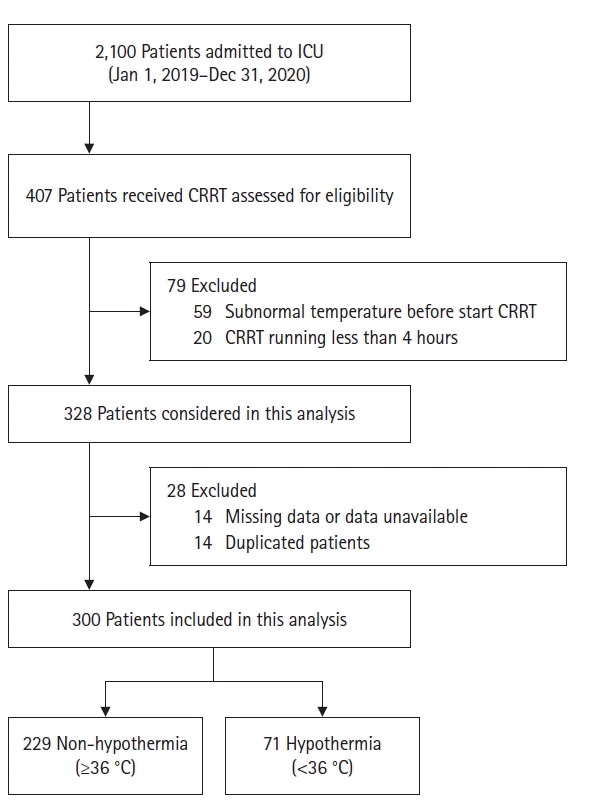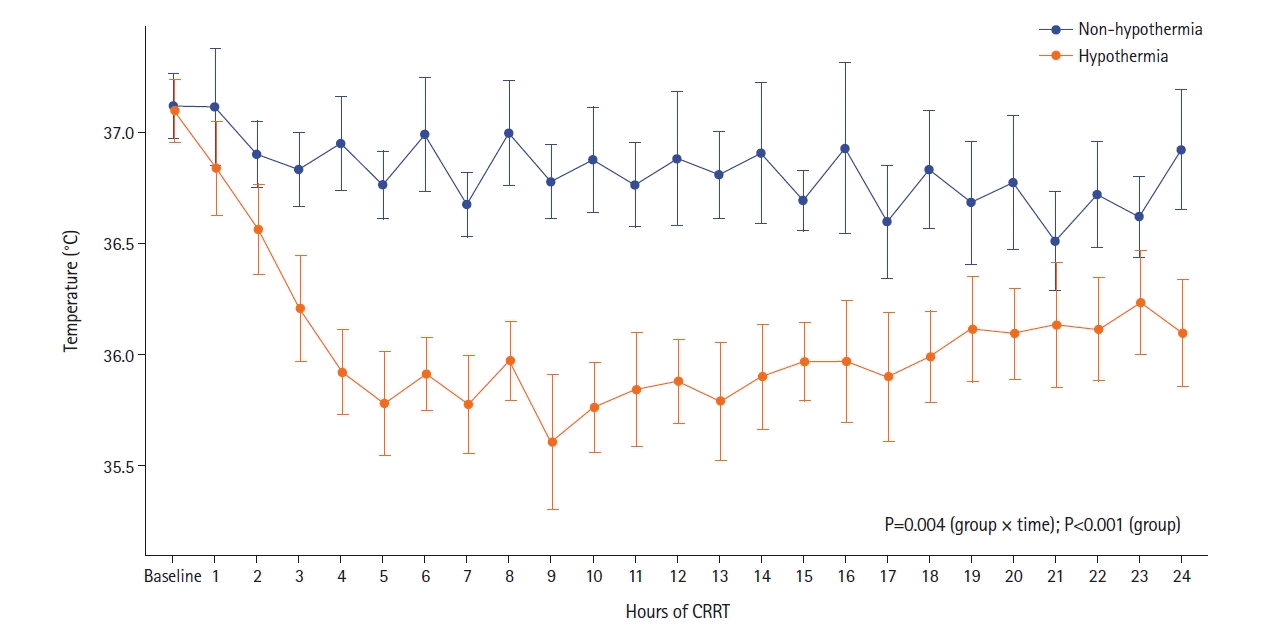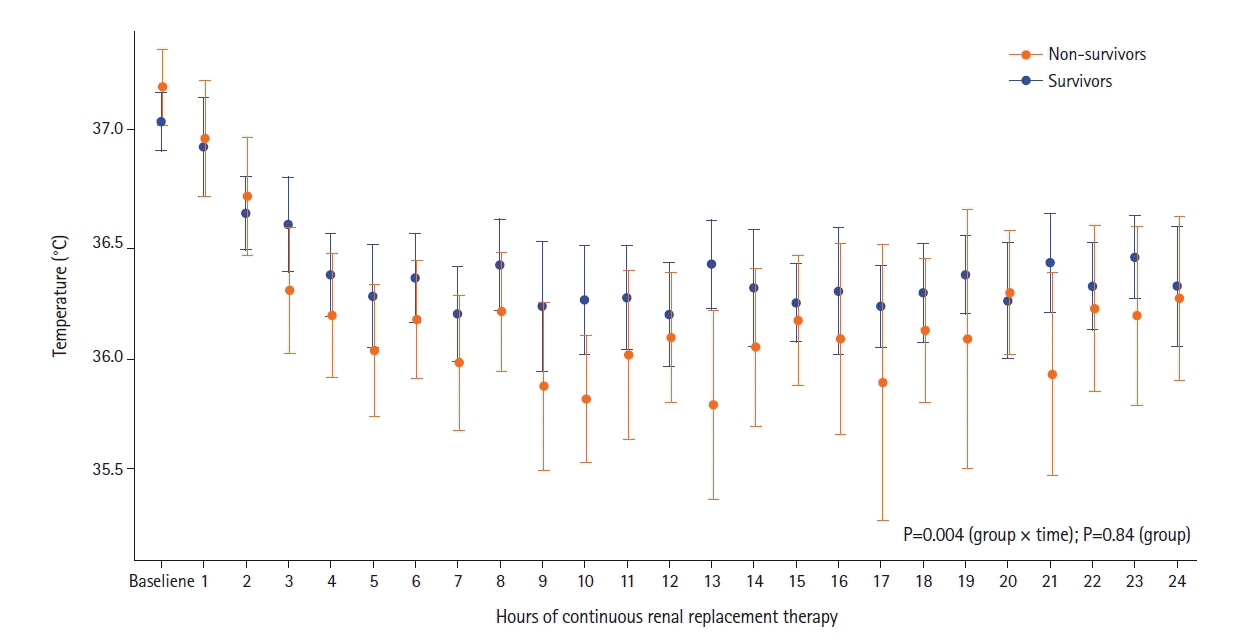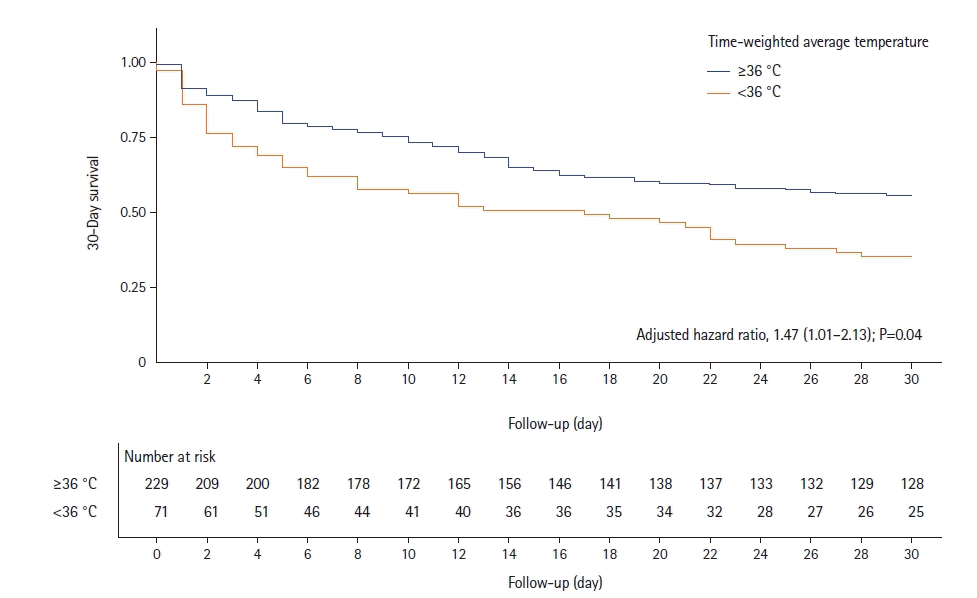Abstract
Background
Methods
Results
Conclusion
Notes
FUNDING
This study was supported by a grant from the Siriraj Research Development Fund (managed by the Routine to Research Project), Faculty of Medicine Siriraj Hospital, Mahidol University.
AUTHOR CONTRIBUTIONS
Conceptualization: TP, TN. Methodology: TP, TN. Formal analysis: TP. Data curation: TP, NK, PP, SA, HK. Visualization: TP, TN. Project administration: TP. Funding acquisition: TP. Writing - original draft: TP, TN. Writing - review & editing: TP, TN. All authors read and agreed to the published version of the manuscript.
ACKNOWLEDGMENTS
SUPPLEMENTARY MATERIALS
Supplementary Table 1.
Supplementary Table 2.
REFERENCES
Figure 1.

Figure 2.

Figure 3.

Figure 4.

Table 1.
| Variable | Non-hypothermiaa) (n=229, 76.3%) | Hypothermiab) (n=71, 23.7%) | P-value |
|---|---|---|---|
| Age (yr) | 66 (53–79) | 74 (61–81) | 0.02 |
| Female | 95 (41.5) | 29 (40.8) | 0.99 |
| Body weight (kg) | 61.8 (54.0–70.9) | 58.0 (50.0–65.0) | 0.03 |
| APACHE II score | 24.0 (20.0–29.0) | 26.0 (22.0–31.5) | 0.01 |
| Comorbidity | |||
| Diabetes | 98 (42.8) | 31 43.7) | 0.99 |
| Hypertension | 144 (62.9) | 42 (59.2) | 0.67 |
| Chronic kidney disease | 133 (58.1) | 37 (52.1) | 0.45 |
| Stage 3 | 44 (19.2) | 14 (19.7) | |
| Stage 4 | 29 (12.7) | 7 (9.9) | |
| Stage 5 | 59 (25.8) | 16 (22.5) | |
| Coronary artery disease | 87 (38.0) | 26 (36.6) | 0.95 |
| Congestive heart failure | 41 (17.9) | 11 (15.5) | 0.77 |
| Liver disease | 39 (17.0) | 7 (9.9) | 0.20 |
| Malignancy | 47 (20.5) | 15 (21.1) | 0.99 |
| Indication for RRT | |||
| Metabolic acidosis | 101 (44.1) | 45 (63.4) | 0.01 |
| Fluid overload | 92 (40.2) | 27 (38.0) | 0.85 |
| Hyperkalemia | 25 (10.9) | 7 (9.9) | 0.97 |
| Sepsis | 129 (56.3) | 49 (69.0) | 0.08 |
| Vasopressor | 184 (80.3) | 60 (84.5) | 0.54 |
| Norepinephrine equivalent dosec) (μg/kg/min) | 0.2 (0.1–0.5) | 0.3 (0.2–0.5) | 0.20 |
| Mechanical ventilator | 201 (87.8) | 68 (95.8) | 0.09 |
| Baseline temperature before CRRT (°C) | 36.9 (36.5–37.6) | 36.8 (36.4–37.5) | 0.34 |
| External warmer | 21 (9.2) | 3 (4.2) | 0.28 |
| ICU mortality | 101 (44.1) | 42 (59.2) | 0.04 |
| Hospital mortality | 134 (58.5) | 51 (71.8) | 0.06 |
| Renal outcome: MAKE30 | 154 (67.2) | 54 (76.1) | 0.21 |
| Mortality at day 30 | 101 (44.1) | 46 (64.8) | 0.004 |
| Doubling serum creatinine | 8 (10.7) | 3 (15.8) | 0.82 |
| RRT dependence | 45 (37.2) | 5 (20.8) | 0.19 |
Table 2.
| Variable | Non-hypothermiaa) (n=229, 76.3%) | Hypothermiab) (n=71, 23.7%) | P-value |
|---|---|---|---|
| Hemoglobin (g/dl) | 8.8 (7.9–10.1) | 9.4 (8.2–10.6) | 0.12 |
| BUN (mg/dl) | 66.0 (41.0–90.0) | 59.0 (38.0–83.5) | 0.16 |
| Creatinine (mg/dl) | 3.6 (2.4–5.4) | 4.0 (2.7–5.5) | 0.26 |
| Fluid balance day before CRRT (mL) | 1,421 (67–3,216) | 1,943 (1,254–4,390) | 0.01 |
| Fluid balance on the day of CRRT (mL) | 744 (–1,926 to 2,767) | 1,850 (–1,071 to 4,758) | 0.04 |
| CRRT modality | 0.25 | ||
| CVVH | 210 (91.7) | 66 (93.0) | |
| CVVHDF | 4 (1.7) | 3 (4.2) | |
| SCUF | 15 (6.6) | 2 (2.8) | |
| Blood flow rate (ml/min) | 200 (150–200) | 200 (150–200) | 0.08 |
| Duration of CRRT (hr) | 19.5 (10.5–24.0) | 21.1 (11.3–24.0) | 0.52 |
| Dose of CRRT (ml/kg/hr) | 30.9 (24.9–35.9) | 33.4 (29.0–38.7) | 0.01 |
| CRRT dose > 30 ml/kg/hr | 120 (52.4) | 50 (70.4) | 0.01 |
| Ultrafiltration (ml/day) | 420 (0–1,790) | 475 (0–1,401) | 0.69 |
| Ultrafiltration (ml/kg/hr) | 0.4 (0.0–1.6) | 0.5 (0.0–1.5) | 0.92 |
| Temperature setting of CRRT (°C) | 37.0 (37.0–38.0) | 37.5 (37.0–38.0) | 0.04 |
| Number of temperature observations | 7.0 (5.0–11.0) | 8.0 (5.0–11.0) | 0.42 |
Table 3.
| Variable |
Univariable model |
Multivariable modela) |
||
|---|---|---|---|---|
| Odds ratio (95% CI) | P-value | Odds ratio (95% CI) | P-value | |
| Age (yr) | 1.02 (1.00–1.03) | 0.005 | 1.02 (1.00–1.04) | 0.05 |
| Age >70 yr | 2.04 (1.19–3.54) | 0.01 | 2.59 (1.38–4.98) | 0.004 |
| Body weight (kg) | 0.97 (0.95–0.99) | 0.01 | 0.89 (0.81–0.97) | 0.01 |
| Metabolic acidosisb) | 2.19 (1.28–3.84) | 0.005 | 1.56 (0.80–3.08) | 0.20 |
| Fluid balance on the day before CRRT (L) | 1.12 (1.03–1.23) | 0.01 | 1.11 (1.02–1.22) | 0.02 |
| Fluid balance on the day of CRRT (L) | 1.10 (1.03–1.17) | 0.007 | 1.10 (1.00–1.21) | 0.05 |
| Dose of CRRT (ml/kg/hr) | 1.04 (1.01–1.06) | 0.01 | 1.003 (1.00–1.01) | 0.04 |
| Temperature of CRRT (°C) | 1.12 (0.91–1.37) | 0.27 | - | - |
Table 4.
Values are presented as mean±standard deviation.
ICU: intensive care unit; TWA: time-weighted average; TWATemp: TWA temperature was calculated as the area under the temperature-versus-time plot; MaximumTemp: maximum temperature in the period of 24 hours of CRRT; MinimumTemp: minimum temperature in the period of 24 hours of CRRT; CV: coefficient of variation; CVTemp: standard deviation of the temperature divided by the mean temperature in the period of 24 hours of CRRT; T-maxTemp: time spent on the maximum temperature in the period of 24 hours of CRRT; T-minTemp: time spent on the minimum temperature in the period of 24 hours of CRRT; AmplitudeTemp: difference between the maximum and the mean temperature in the period of 24 hours of CRRT; CRRT: continuous renal replacement therapy.
Table 5.
| Temperature indices |
Univariable models |
Multivariable modelsa) |
||
|---|---|---|---|---|
| Odds ratiob) (95% CI) | P-value | Odds ratiob) (95% CI) | P-value | |
| TWATemp | 0.70 (0.47–0.99) | 0.05 | 0.85 (0.57–1.25) | 0.41 |
| MaximumTemp | 1.16 (0.88–1.53) | 0.30 | 1.18 (0.88–1.58) | 0.27 |
| MinimumTemp | 0.69 (0.53–0.88) | 0.003 | 0.76 (0.57–1.00) | 0.05 |
| CVTemp | 1.46 (1.19–1.82) | < 0.001 | 1.41 (1.13–1.78) | 0.003 |
| T-maxTemp | 0.96 (0.93–0.99) | 0.01 | 0.97 0.93–1.00) | 0.05 |
| T-minTemp | 1.00 (0.97–1.04) | 0.98 | 1.00 (0.96–1.04) | 0.99 |
| AmplitudeTemp | 1.49 (1.09–2.06) | 0.01 | 1.32 (0.94–1.88) | 0.12 |
Values are presented mean±standard deviation. Temperature was expressed as degree Celsius. Each model was adjusted with factors including age, body weight, fluid balance before continuous renal replacement therapy, dose of continuous renal replacement therapy.
ICU: intensive care unit; TWA: time-weighted average; TWATemp: TWA temperature was calculated as the area under the temperature-versus-time plot; MaximumTemp: maximum temperature in the period of 24 hours of CRRT; MinimumTemp: minimum temperature in the period of 24 hours of CRRT; CV: coefficient of variation; CVTemp: standard deviation of the temperature divided by the mean temperature in the period of 24 hours of CRRT; T-maxTemp: time spent on the maximum temperature in the period of 24 hours of CRRT; T-minTemp: time spent on the minimum temperature in the period of 24 hours of CRRT; AmplitudeTemp: difference between the maximum and the mean temperature in the period of 24 hours of CRRT; CRRT: continuous renal replacement therapy.




 PDF
PDF Citation
Citation Print
Print



 XML Download
XML Download